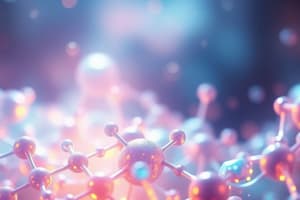Podcast
Questions and Answers
What is the characteristic structure of the polyphosphazene backbone?
What is the characteristic structure of the polyphosphazene backbone?
- Alternating phosphorus and oxygen atoms
- Alternating phosphorus and nitrogen atoms (correct)
- Alternating silicon and nitrogen atoms
- Alternating germanium and phosphorus atoms
What is the typical reaction involved in the synthesis of polyphosphazenes?
What is the typical reaction involved in the synthesis of polyphosphazenes?
- Reaction of silicon with a base
- Reaction of oxygen with a polyphosphazene
- Reaction of a phosphorus(III) halide with an azide (correct)
- Reaction of germanium with a Lewis acid
What is a potential application of polyphosphazenes?
What is a potential application of polyphosphazenes?
- Catalysts in chemical reactions
- Pigments in coloring materials
- Fuel cells and energy storage
- Materials for ionic conductors and sensors (correct)
What is a common modification made to polyphosphazenes?
What is a common modification made to polyphosphazenes?
What are the three types of inorganic polymers discussed in this article?
What are the three types of inorganic polymers discussed in this article?
What is a characteristic of polyphosphazenes resulting from their synthesis?
What is a characteristic of polyphosphazenes resulting from their synthesis?
What is the backbone of silicones composed of?
What is the backbone of silicones composed of?
What is the typical reaction involved in the synthesis of silicones?
What is the typical reaction involved in the synthesis of silicones?
Which of the following is a potential application of polythiazyl polymers?
Which of the following is a potential application of polythiazyl polymers?
What is the backbone of polythiazyl polymers composed of?
What is the backbone of polythiazyl polymers composed of?
What is a common property of inorganic polymers, such as silicones and polythiazyl polymers?
What is a common property of inorganic polymers, such as silicones and polythiazyl polymers?
In which industry are inorganic polymers, such as silicones and polythiazyl polymers, often used?
In which industry are inorganic polymers, such as silicones and polythiazyl polymers, often used?
Flashcards are hidden until you start studying
Study Notes
Inorganic polymers are a class of materials that contain heavy elements, such as silicon, germanium, and phosphorus, in their backbones. These polymers have unique properties and are often used in high-performance applications. In this article, we will discuss three types of inorganic polymers: polyphosphazenes, silicones, and polythiazyl polymers.
Polyphosphazenes
Polyphosphazenes are a class of inorganic polymers that are based on the phosphazene backbone. This backbone consists of alternating phosphorus and nitrogen atoms, with the nitrogen atoms being part of a phosphorus-nitrogen-phosphorus repeat unit. Polyphosphazenes can be modified by attaching various organic or inorganic groups to the phosphorus atoms, resulting in a wide range of properties and applications.
Synthesis and Properties
The synthesis of polyphosphazenes typically involves the reaction of a phosphorus(III) halide with an azide, such as sodium azide, in the presence of a base. This reaction forms a polynitrile, which can then be transformed into a polyphosphazene by heating in the presence of a Lewis acid. The resulting polymer has a high thermal stability and a wide range of mechanical properties.
Polyphosphazenes have been used in various applications, including drug delivery systems, lubricants, and as protective coatings. They have also been studied for their potential use as materials for ionic conductors and sensors.
Silicones
Silicones, also known as polysiloxanes, are a type of inorganic polymer that is based on the silicon-oxygen backbone. This backbone consists of alternating silicon and oxygen atoms, with the silicon atoms being part of a silicon-oxygen-silicon repeat unit. Silicones are known for their low toxicity, high thermal stability, and excellent dielectric properties.
Synthesis and Properties
The synthesis of silicones typically involves the reaction of a silicon-containing compound, such as tetramethyldisiloxane, with a suitable organic compound, such as a diol. This reaction forms a siloxane backbone, which can then be further functionalized by attaching various organic groups to the silicon atoms.
Silicones are widely used in various applications, including as lubricants, sealants, and in the production of silicone rubber. They are also used in the electronics industry due to their excellent dielectric properties and their ability to withstand high temperatures.
Polythiazyl Polymers
Polythiazyl polymers are a class of inorganic polymers that are based on the thiazyl backbone. This backbone consists of alternating nitrogen and sulfur atoms, with the nitrogen atoms being part of a nitrogen-sulfur-nitrogen repeat unit. Polythiazyl polymers have been studied for their potential use as materials for electronic applications, such as in sensors and solar cells.
Synthesis and Properties
The synthesis of polythiazyl polymers typically involves the reaction of a thiazyl monomer, such as thiazyl chloride, with a suitable organic compound, such as an amide. This reaction forms a thiazyl backbone, which can then be further functionalized by attaching various organic groups to the nitrogen and sulfur atoms.
Polythiazyl polymers have been studied for their potential use in electronic applications due to their high electrical conductivity and their ability to form stable organic-inorganic hybrid materials.
In conclusion, inorganic polymers, such as polyphosphazenes, silicones, and polythiazyl polymers, have unique properties and are used in various high-performance applications. They offer a wide range of properties and are often used in the electronics industry, as well as in the production of materials for sensors and solar cells.
Studying That Suits You
Use AI to generate personalized quizzes and flashcards to suit your learning preferences.




